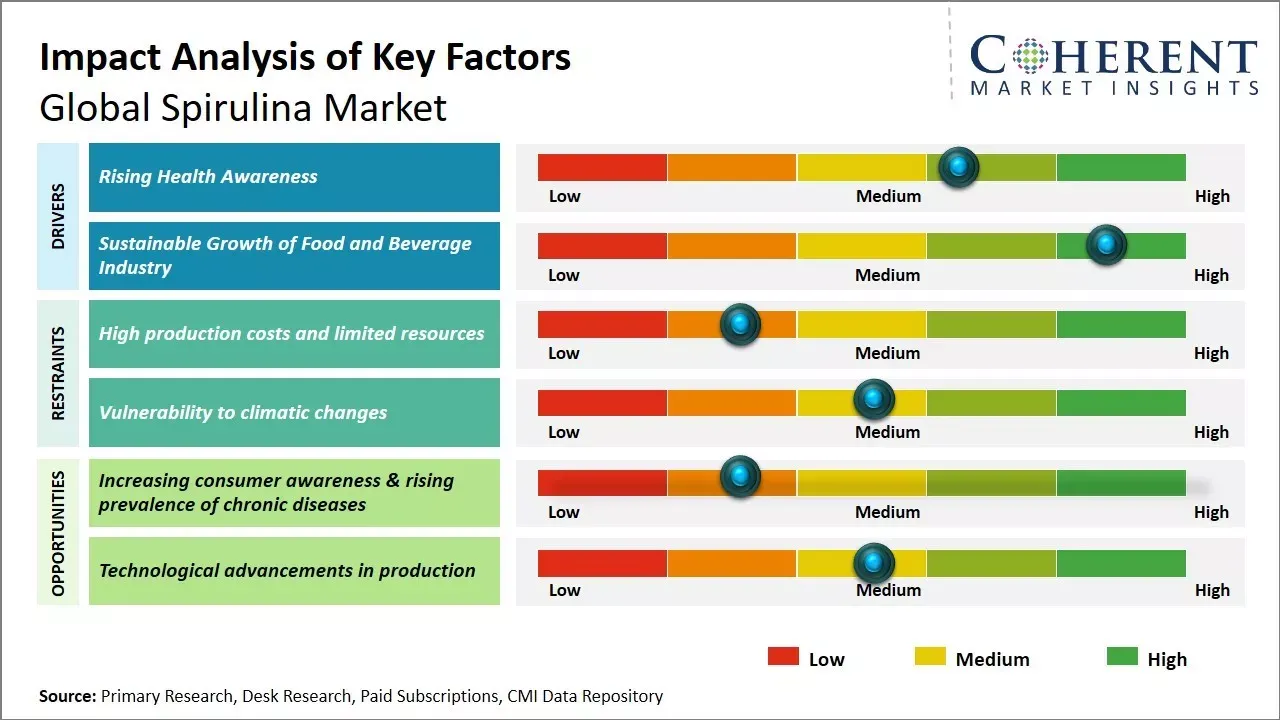The global spirulina market is estimated to be valued at USD 522.6 Mn in 2025 and is expected to reach USD 884.6 Mn by 2032, growing at a compound annual growth rate (CAGR) of 7.8% from 2025 to 2032.

To learn more about this report, Download Free Sample
The world spirulina market is witnessing steady growth due to increased consumer demand for natural, high-nutrient superfoods and growing awareness of the health advantages of plant-based proteins. The market is driven by the rising popularity of functional foods, clean-label products, and dietary supplements among health-conscious consumers. The driving forces include increased veganism, the need for sustainable food sources, and established benefits of spirulina in immunity, detoxification, and anti-aging. The market spans powdered, tablet, capsule, and liquid spirulina forms, commonly used in food & beverages, nutraceuticals, cosmetics, and aquaculture.
|
Current Events |
Description and its impact |
|
Rise in Organic Spirulina Cultivation and Certification Programs
|
|
|
Blue Spirulina (Phycocyanin) Expansion in Functional Foods and Beverages |
|
Uncover macros and micros vetted on 75+ parameters: Get instant access to report
People are becoming more conscious about their health and wellbeing. There is a greater focus on maintaining overall physical fitness and immunity as well as reducing risk of various diseases. Spirulina is gaining popularity due to its enriching nutritional profile. It is packed with protein, vitamins, minerals, and other nutrients that are beneficial for health. The super food is known to boost energy levels, support digestive health, lower cholesterol, and blood pressure.
Regular consumption can also aid in weight management and boost cognitive functions. With rising health issues like obesity, diabetes, and cardiovascular problems, people are seeking natural dietary supplements and super foods like spirulina to fulfill their nutritional requirements. Busy lifestyles and lack of balanced diets have contributed to various deficiencies as well. Spirulina bridges the gap very well as a standalone source of nutrients. It is also becoming a favored addition in smoothies, juices, tablets, and snacks.
In 2024, the UK's top smoothie and juice brand, Innocent Drinks, introduced a new product, Blueberry Focus Smoothie, which contains spirulina. Spirulina is combined in the drink with blueberries, strawberries, rhubarb, apples, and extra vitamin B5 for improved mental performance and energy. The introduction is specifically aimed at health-aware consumers in need of healthy, nutrient-dense foods to aid busy lifestyles.
The global food and beverage industry has been witnessing exponential expansion. There is massive spending on R&D for new product innovations to cater to evolving consumer needs. Companies are actively exploring ingredients and formulations that provide functional benefits. They are leveraging super foods like spirulina for enhancing nutritional value of existing food items and developing new ranges of fortified foods, supplements and beverages.
The super food has garnered interest of major players in the food, dietary and cosmetic sectors due to its versatile applications and impressive functional profile. Its usage in animal feed aids in reducing environmental impact of livestock farming. Therefore, the growing food and beverage industry is expected to drive the market growth. For instance, according to data published by Invest India in 2022, by 2025, the Indian food processing market is estimated to reach USD 535 Bn, growing at a compound annual growth rate of 15.2%.
Increasing consumer awareness about the nutritional value and therapeutic properties of spirulina is driving its demand worldwide. Rising prevalence of chronic diseases will boost its application in pharmaceuticals and nutraceuticals. Moreover, spirulina is increasingly recognized as a sustainable super food and natural colorant, offering opportunities for product innovation and development across new application segments.

To learn more about this report, Download Free Sample
The form segment dominates the global spirulina market due to its convenience and longer shelf life compared to other forms. This segment is expected to contribute 45.5% of the market share in 2025. Powdered spirulina is convenient to use as it can be easily mixed into drinks, smoothies, baked goods, or other foods. Its dry form means it does not require refrigeration like liquids and can simply be stored in a cool, dry place. This makes it ideal for commercial producers and distributors who want to supply spirulina to retailers with longer distribution chains.
Powdered spirulina has a shelf life of up to two years unopened when stored properly, whereas liquid forms may only last a few months refrigerated. Many nutraceutical products contain spirulina powder due to its ability to be encapsulated or blended homogeneously into formulations. This versatility has led to powdered spirulina being used extensively in supplement blends targeting health issues like inflammation, cardiovascular support and digestive wellness. Its use in food and beverage applications as a coloring agent, thickener or protein fortifier also relies on its ability to dissolve when in powder form.
The protein composition segment is expected to contribute 36.2% share of the global spirulina market in 2025, due to spirulina's high protein content and resulting popularity in dietary supplements and foods. Spirulina contains approximately 60-70% complete protein by dry weight, making it one of the richest non-animal sources. It contains all essential amino acids along with various other nutrients.
Spirulina's protein quality compares favorably to meat, eggs and dairy, while containing more easily digestible proteins than soy or other plant alternatives. Its protein content has driven spirulina adoption into numerous nutraceutical and sports nutrition products. Protein supplements often feature spirulina as a key ingredient to support muscle growth and recovery.
The food and beverages segment holds the leading share of the global spirulina market due to the wide scope of its applications and associated nutritional benefits being promoted in this industry. This segment is expected to contribute 39% of the market share in 2025. Food companies are increasingly incorporating spirulina into products aimed at health-conscious consumers. It provides a natural green colorant and flavour comparable to common plant-based alternatives like spinach or kale.
Beyond physical attributes, spirulina offers an array of potential health advantages that food formulators aim to leverage. These include antioxidants, anti-inflammatory compounds, and ability to support cardiovascular, brain, and digestive functions when consumed regularly.
Products target distinct segments like children through spirulina-enhanced puffed snacks or seniors with joint health juice blends. Vegan foods are enriched with spirulina’s protein and nutrients as a more sustainable alternative to meat analogs. The food and beverage industry sees great potential for spirulina as a solution for developing cleaner, more beneficial product lines.

To learn more about this report, Download Free Sample
North America is the current dominant region in the global spirulina market. The region is expected to hold 37.2% of the market share in 2025. With the rising health consciousness and increasing awareness about the nutritional benefits of spirulina, its demand has grown substantially among consumers in the U.S. and Canada.
Americans widely consume spirulina as a nutritional supplement for its high protein content and other health advantages. The region is also a leader in spirulina production, with several large producers based in the U.S. and Mexico. The established manufacturing infrastructure and technical expertise in the cultivation and processing of spirulina have aided its mass production in North America over the years.
Asia Pacific demonstrates the fastest growth and shows promising potential in the coming years. Countries like India, China, and Thailand have emerged as new production hubs and the market is gaining rapid traction in these developing economies. This can be attributed to the increasing domestic demand as more people include spirulina in their regular diets for its antioxidant and anti-inflammatory properties.
Furthermore, the favorable climate conditions in many Asian countries provide ideal natural environments for spirulina cultivation. The growth is also supplemented by supportive government initiatives and investments to encourage algae farming and exports. With rising health consciousness, growing incomes, and a large consumer base, the Asia Pacific region is expected to dominate the global spirulina industry landscape in the long run.
The U.S. dominates spirulina product innovation and consumption, fueled by robust demand for plant-based dietary supplements, functional foods, and clean-label ingredients. Large producers such as Earthrise Nutritionals and Nutrex Hawaii emphasize organic and high-purity spirulina to meet the needs of a mature health-oriented market.
India is a leading producer and exporter of bulk spirulina, based on low production cost and favorable climate. International players like E.I.D. Parry and Prolgae are major suppliers globally, with increasing emphasis on organic and sustainable cultivation practices.
| Report Coverage | Details | ||
|---|---|---|---|
| Base Year: | 2024 | Market Size in 2025: | USD 522.6 Mn |
| Historical Data for: | 2020 To 2024 | Forecast Period: | 2025 To 2032 |
| Forecast Period 2025 to 2032 CAGR: | 7.8% | 2032 Value Projection: | USD 884.6 Mn |
| Geographies covered: |
|
||
| Segments covered: |
|
||
| Companies covered: |
Cyanotech Corporation, Sensient Technologies Corporation, NB Laboratories Pvt Ltd, DIC Corporation, Fuqing King Dnarmsa Spirulina Co. Ltd, Evergreen Agro Creations, Indian Agri Farm, Alpspure Lifesciences Pvt. Ltd., Ideal Natural Extract, Lifevision Healthcare, Grenera Nutrients Private Limited, and Far East Bio-Tec Co., Ltd. |
||
| Growth Drivers: |
|
||
| Restraints & Challenges: |
|
||
Uncover macros and micros vetted on 75+ parameters: Get instant access to report
*Definition: The global spirulina market comprises companies that cultivate and harvest the microalgae spirulina, then process, and sell it for consumption. Spirulina is marketed as a dietary supplement due to its high nutrient content including protein, B vitamins, carotenoids, and other antioxidants.
Share
Share
About Author
Pankaj Poddar is a seasoned market research consultant with over 12 years of extensive experience in the fast-moving consumer goods (FMCG) and plastics material industries. He holds a Master’s degree in Business Administration with specialization in Marketing from Nirma University, one of India’s reputed institutions, which has equipped him with a solid foundation in strategic marketing and consumer behavior.
As a Senior Consultant at CMI for the past three years, he has been instrumental in harnessing his comprehensive understanding of market dynamics to provide our clients with actionable insights and strategic guidance. Throughout his career, He has developed a robust expertise in several key areas, including market estimation, competitive analysis, and the identification of emerging industry trends. His approach is grounded in a commitment to understanding client needs thoroughly and fostering collaborative relationships. His dedication to excellence and innovation solidifies his role as a trusted advisor in the ever-evolving landscape of not only FMCG but also chemicals and materials markets.
Missing comfort of reading report in your local language? Find your preferred language :
Transform your Strategy with Exclusive Trending Reports :
Frequently Asked Questions
Joining thousands of companies around the world committed to making the Excellent Business Solutions.
View All Our Clients